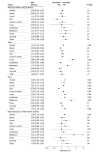Racial Disparities in Cancer Stage at Diagnosis and Survival for Adolescents and Young Adults
- PMID: 39212989
- PMCID: PMC11365006
- DOI: 10.1001/jamanetworkopen.2024.30975
Racial Disparities in Cancer Stage at Diagnosis and Survival for Adolescents and Young Adults
Abstract
Importance: There are limited studies assessing stage at diagnosis and risk of death among all 5 federally defined races in the US among adolescent and young adult (AYA) patients with cancer.
Objective: To identify racial disparities in stage at diagnosis and survival among AYA patients with cancer.
Design, setting, and participants: This retrospective cohort study used data from a US national hospital-based oncology database on AYA patients, aged 15 to 39 years, with the 10 deadliest cancers among AYA patients who received a diagnosis from January 1, 2004, to December 31, 2017, with 6 months or more of follow-up. Analyses by race were categorized by the 5 federally defined races in the US: American Indian or Alaska Native, Asian, Black, Native Hawaiian or Other Pacific Islander, and non-Hispanic White (hereafter, White). White patients served as the majority reference group. Statistical analysis was performed from November 2022 to September 2023.
Main outcomes and measures: The primary end points were late stage at diagnosis (logistic regression with adjusted odds ratios [AORs] and 95% CIs) and overall survival (log-rank tests and Cox proportional hazards regression with adjusted hazard ratios [AHRs] and 95% CIs).
Results: A total of 291 899 AYA patients (median age, 33 years [IQR, 28-37 years]; 186 549 female patients [64%]; 189 812 [65%] with stage I or II cancers) were evaluated. The cohort included 1457 American Indian or Alaska Native patients (1%), 8412 Asian patients (3%), 40 851 Black patients (14%), 987 Native Hawaiian or Other Pacific Islander patients (0.3%), and 240 192 White patients (82%). Cancers included breast (n = 79 195 [27%]), lymphoma (n = 45 500 [16%]), melanoma (n = 36 724 [13%]), testis (n = 31 413 [11%]), central nervous system (n = 26 070 [9%]), colon or rectum (n = 22 545 [8%]), cervix (n = 20 923 [7%]), sarcoma (n = 14 951 [5%]), ovary (n = 8982 [3%]), and lung (n = 5596 [2%]). Risk of late-stage diagnosis was higher for Asian (AOR, 1.20; 95% CI, 1.14-1.26), Black (AOR, 1.40; 95% CI, 1.36-1.43), and Native Hawaiian or Other Pacific Islander (AOR, 1.34; 95% CI, 1.16-1.55) patients compared with White patients. Overall survival differed by race for all cancer sites, except cancers of the central nervous system and ovary. Risk of death was higher for American Indian or Alaska Native (AHR, 1.15; 95% CI, 1.02-1.30), Black (AHR, 1.22; 95% CI, 1.19-1.26), and Native Hawaiian or Other Pacific Islander (AHR, 1.25; 95% CI, 1.09-1.44) patients but lower for Asian patients (AHR, 0.90; 95% CI, 0.85-0.95) compared with White patients.
Conclusions and relevance: This cohort study of AYA patients suggests that stage at diagnosis and survival varied across races for the 10 deadliest AYA cancers. These results support the need for tailored interventions and informed public policy to achieve cancer care equity for all races.
Conflict of interest statement
Figures



References
-
- National Cancer Institute . Cancer stat facts: cancer among adolescents and young adults (AYAs) (ages 15-39). 2023. Accessed August 28, 2023. https://seer.cancer.gov/statfacts/html/aya.html
Publication types
MeSH terms
LinkOut - more resources
Full Text Sources
Medical

